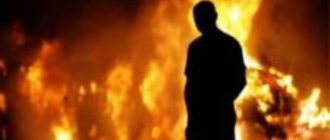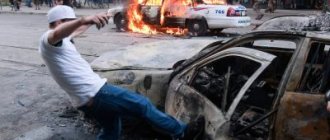1. Deliberate destruction or damage to someone else’s property, if these acts entailed the infliction of significant damage, is punishable by a fine in the amount of up to forty thousand rubles or in the amount of the wages or other income of the convicted person for a period of up to three months, or by compulsory labor for a period of up to three hundred and sixty hours. , or correctional labor for a term of up to one year, or forced labor for a term of up to two years, or arrest for a term of up to three months, or imprisonment for a term of up to two years.
2. The same acts committed out of hooligan motives, by arson, explosion or other generally dangerous method, or which through negligence resulted in the death of a person or other grave consequences, are punishable by forced labor for a term of up to five years or imprisonment for the same term.
Commentary on Article 167 of the Criminal Code of the Russian Federation
1. Destruction presupposes the cessation of the physical existence of a thing and the complete unsuitability of its use for its intended purpose. Damage is characterized by a partial violation of the physical integrity of a thing, usually leading to a deterioration in its useful properties, their partial or temporary loss, which can be restored through repair, restoration, etc.
2. A mandatory sign of the objective side of a crime is a socially dangerous consequence in the form of causing significant damage to the owner or legal possessor of the property. The crime is considered completed at the moment the specified consequence occurs.
When deciding whether significant damage has been caused to the owner or other holder of property, one should proceed from the value of the destroyed property or the cost of restoring damaged property, the significance of this property for the victim, for example, depending on the type of his activity and financial situation or the financial and economic state of the legal entity. a person who was the owner or other possessor of the destroyed or damaged property.
3. The subjective side is characterized by an intentional form of guilt.
4. The subject of the crime is a person who has reached the age of 16 years.
5. Qualified personnel (Part 2 of Article 167) are formed by the acts specified in the commented article, committed out of hooligan motives, by arson, explosion or other generally dangerous method, or which, through negligence, resulted in the death of a person or other grave consequences.
6. On the concept of hooligan motives and generally dangerous methods, see the commentary of Art. 105 of the Criminal Code.
7. Arson involves the use of fire, and an explosion involves the use of special devices of great destructive power based on powder and other gases. Intentional destruction or damage to someone else's property, committed by arson, is qualified under Part 2 of Art. 167 only in cases where, according to the conditions of the commission, this method is of a generally dangerous nature <1>.
——————————— <1> BVS of the Russian Federation. 2006. N 7.
Deliberate destruction or damage to individual objects using fire under conditions that exclude its spread to other objects and the emergence of a threat of harm to the life and health of people, as well as other people’s property, must be qualified under Part 1 of Art. 167, if the victim suffered significant damage.
8. Other grave consequences can be very diverse:
- causing harm to the health of at least one person, loss of life, mass poisoning, spread of epidemics, epizootics, death of animals, destruction of vegetation, etc., as well as leaving victims without housing or means of subsistence;
— long-term suspension or disorganization of the work of an enterprise, institution or organization;
— long-term disconnection of consumers from life support sources: electricity, gas, heat, water supply, etc.
Causing death or serious harm to the health of people entails liability under the commented article only if they are treated carelessly. If there is intent, additional qualifications are required under Art. Art. 105 or 111 of the Criminal Code.
9. Responsibility for committing the crime in question under aggravating circumstances begins at the age of 14.
Where to file a complaint about property damage and how to file it?
To the police or to the court.
In a statement to the police regarding damage to property
(officially: upon the fact of intentional destruction or damage to property or destruction or damage of property through negligence) the
following are indicated
:
Full name and title of the head of the department to which the application is being submitted, as well as the name of the department itself;
Department address with index;
Full name of the applicant and address with zip code for receiving correspondence (mail). It is advisable to indicate the address of registration and residence;
• Full name and title of the head of the department to which the application is being submitted, as well as the name of the department itself;
• department address with index;
• Full name of the applicant and address with a zip code for receiving correspondence (mail), preferably indicating the address of registration and residence;
• mobile phone for feedback;
• email address for feedback;
• title of the statement: “Statement of a crime”;
• the text of the statement itself. In this text, indicate the circumstances under which your property was intentionally damaged or destroyed by the criminal, the amount of damage caused to you by the crime, and other circumstances under which the crime was committed. It is necessary to describe as clearly and concisely as possible the circumstances under which the crime occurred.
Next, you must indicate all the information you have about the criminal or criminals, their phone numbers, evidence that you can present against the criminals, and the circle of people you suspect of committing this crime.
At the end of the application, indicate the phrase: “I am aware of liability for knowingly false denunciation under Article 306 of the Criminal Code of the Russian Federation”;
• attachment: list the evidence that you attach to the application for this case, copies of documents;
• date of application and your signature with transcript.
How is the crime determined: reasons for arson
If a citizen has committed arson , then to qualify this crime, its elements are considered. Its important component is the subjective side of the act, since it could be committed with or without intent.
What does this mean:
- arson is considered committed with intent if a citizen set fire to someone else’s property and at the same time was fully aware of the negativity of his act, and also wanted serious consequences to occur;
- unintentional in cases where a person knew what the fire would lead to, but did not want its negative result.
The object of the offense is the objects of someone else's property: a vehicle, real estate, as well as the safety, health and life of citizens.
The objective side of the act is causing varying degrees of harm to someone else’s property or another person.
The subject of the crime is a legally competent citizen who has reached the required age by law.
The subject of arson is usually other people's property.
Evidence
To prove that the destruction of someone else's property as a result of arson actually took place, an investigation is conducted.
During it, evidence is collected that would help establish the reasons for the arson and how it was committed. This could be any explosive or chemical substances, abandoned matches, or lighters.
A survey is also conducted of those persons who were at the scene of the incident or nearby during the fire , CCTV camera records are reviewed, if any, and other citizens who could have filmed the incident on a photo or video camera are also involved.
Statistics
Arson is the most socially dangerous and, unfortunately, quite common cause of fire.
Abroad, in developed Western countries, according to statistics, there are much more of them than in Russia. In the United States, up to 40% of all urban structure fires are the result of arson. It causes more than $1 billion in direct losses and more than $10 billion in indirect losses, more than 500 deaths, and 5,000 injuries each year in the United States (1994 statistics).
In the UK, the Fire Protection Association, in its 1992-1993 report, stated that 48% of all major fires were the result of arson.
In the West, billions of dollars are invested in government programs to combat arson. Insurance companies are also actively involved in financing.
In Russia, the proportion of fires caused by arson is, according to statistical data, about 9%. It would seem that the picture is quite favorable compared to other countries and the problem of arson does not seem to exist. But there are circumstances that do not allow one to believe in such goodness.
Arson using a lighter
Firstly, the percentage of arson in the total number of fires that occurred is slowly but steadily growing - from 5.3% in 1998 to 8.15% in 2005 and 9.4% in 2009. Secondly, the absolute number of arson incidents across the country is impressive (17,682 in 2009) and the direct damage from them is more than 2 billion rubles.
In addition, statistics record only so-called “identified arson”, i.e. the cases are completely obvious.
The data on the perpetrators of the arson is interesting. Thus, in 1997, out of 14,807 arson incidents, in 10,819 cases (73%!) the culprit was not identified. And this despite the fact that local people are trying in every possible way not to call arson arson without obvious signs of it, or even without an identified specific arsonist.
Of course, A.K. is right. Mikeev, when he states: “...Currently, to qualify a crime under Part 2 of Art. 167 of the Criminal Code of Russia, the presence of objective data on arson obtained during inspection of the scene of the incident (canisters with flammable substances, traces of explosives, etc.) is not enough; the prosecutor's office requires the presence of the subject of the crime, citing the fact that without ascertaining his intent it is impossible to qualify the act. Thus, objective data obtained during inspection of the scene of the incident are not taken into account and the actions of unidentified persons, as a rule, are qualified under Art. 168 of the Criminal Code of Russia" (i.e., as destruction of property due to negligence).
On this topic ▼
Fires and their consequences in Russia compared to the USA
Often, the initiation of criminal cases for arson is also refused due to the absence of significant material damage, and the concept of “significant damage” is interpreted too broadly.
Let us note that fires that occurred as a result of the so-called “careless handling of fire” account for almost half of the total number of fires (49.9% in 2005, 42.8% in 2009).
From the above data, a rather sad picture emerges of the state of affairs with the investigation of arson - fires, in essence, the most criminal. It is obvious that there is a very large proportion of latent (hidden) crimes here. And statistical data is a reflection of our ability (or, more precisely, inability) to establish the fact of arson and prove it.
Of course, investigating arson and bringing those responsible to justice is a very difficult and time-consuming matter. The reasons for this are, to a certain extent, international in nature. Let us give a long, but very accurate and fair quote from J. DeHaan:
...First , a thorough investigation must be conducted before determining that this crime actually occurred. It's not like finding a dead body and a bloody knife as evidence of a murder. Such objects immediately attract the attention of investigators, who are already warned to be careful not to destroy evidence, unlike a normal fire, where the investigation may be carried out superficially, if at all. Therefore, it is imperative that every fire be investigated as if it were arson until conclusive evidence is found that the fire was natural or accidental.
Secondly, the crime itself, if carried out successfully, destroys material evidence of its origin. In some cases, proving the fact of arson is the same as investigating a murder when the victim’s body has turned to dust. There is still evidence of its existence, but it requires careful and methodical analysis. Arson is a crime that destroys evidence rather than creates it.
Third, a formal arson investigation falls somewhere between the responsibilities of the fire department and the police. Firefighters may believe that their primary job is to ensure public safety by putting out fires. They may believe that the testimony, interviews, and searches for physical evidence necessary in a criminal investigation are outside their scope of work and are more suitable for the police. On the other hand, police investigators understand that dealing with physical evidence such as fire characteristics, objects, and charred remains requires specialized knowledge that they do not have, and may be reluctant to work with it. As a result, valuable material evidence may be ignored.
The above quote describes a situation very similar to the Russian one. In accordance with the Code of Criminal Procedure of the Russian Federation, arson today falls under the jurisdiction of the police. But in reality, in most cases, only fire investigators work “hot on the trail” (and even then not always). They must identify the fact of arson and collect evidence of it. In fact, it depends on their desire and skill whether a given arson (or series of arsons) will have at least some prospects of being solved.
Which article does it belong to?
Deliberate arson is considered in Article 167 of the Criminal Code of the Russian Federation. It is also an article for arson of a car, since this act involves causing significant damage as a result of a fire.
Arson also appears as a consequence of such an offense as violation of fire safety rules , therefore it is also interpreted by Art. 219 of the Criminal Code of the Russian Federation.
Attention! If a person died as a result of the incident, then the actions of the perpetrator will be qualified under Art. 109 of the Criminal Code of the Russian Federation, which determines preventive measures for killing a person through negligence. The crime in this case will be considered in conjunction with Art. 167 of the Criminal Code of the Russian Federation.
Let's say that as a result of the incident some property of a citizen , then Art.
167 will be used in conjunction with Art. 168 of the Criminal Code of the Russian Federation, which qualifies damage to property. The Code of Administrative Offenses of the Russian Federation has Art. 20.4, which provides for a fine in case of grass burning (from the point of view of the legislation of the Russian Federation, this is not such a serious crime).
There is a separate article for arson of a forest - Art. 261 of the Criminal Code of the Russian Federation. It consists of two parts that determine the punishment for intentional and unintentional arson.
Depending on the circumstances of the incident, this act may also be qualified under these articles of the Criminal Code of the Russian Federation:
- Part 1 Art. 205, if the arson took place during a terrorist act;
- Part 1 Art. 212 - if committed during mass riots;
- when causing serious harm to health - Art. 112 or lung - Art. 115.
Statement of claim for damage to property in court
To compensate for damages from this crime, it will be necessary to file a statement of claim with the court in which the criminal case is being heard, before the court renders a verdict in the criminal case (a civil claim in a criminal proceeding) or to file a corresponding statement with the court at the defendant’s place of residence after the corresponding court conviction. This statement of claim is not subject to state duty in accordance with Article 333.36 of the Tax Code of the Russian Federation, part 1, paragraph 4.
If the amount of the claim is 50 thousand rubles, the statement of claim is submitted to the magistrate court; if the amount of the claim is over 50 thousand - to the district (city) court.
A court's acquittal does not deprive you of the right to compensation for harm on the basis of Article 1064 of the Civil Code of the Russian Federation in the general manner. If a person is found not guilty of committing a crime, you can still recover money from the defendant by filing a claim for damages, but the claim will be subject to a state fee and will be called a “claim for damages.”
The statement of claim must be drawn up taking into account the requirements set out in Articles 131 and 132 of the Civil Procedure Code of the Russian Federation.
Dear spark
A fire in an apartment building is, unfortunately, a common occurrence. And this is confirmed by the statistics of the Ministry of Emergency Situations - apartments in large and small cities burn with enviable regularity. We can safely say that not a day goes by without fires in apartments.
But after the fire is extinguished, additional extremely unpleasant things usually become clear: we are talking about the damaged apartments of neighbors.
It often happens that the damage to nearby apartments from fire, water and, in general, from the work of firefighters, is many times greater than the losses of the fire victims themselves.
Our dispute began when a lady, a neighbor of the fire victims, filed a lawsuit in one of the district courts of Bashkiria.
In court, the plaintiff said that her neighbors’ apartment burned down. As a result of this emergency, significant damage was caused to her own apartment. The housing damaged by a neighbor's fire had to be seriously repaired. The cost of repairs exceeded one hundred thousand rubles.
No criminal case was opened regarding the fire. Judging by the investigator’s findings, the fire occurred due to the fault of one of the owners of the burnt apartment due to “careless handling of fire.”
The plaintiff asked the court to oblige the neighbors to reimburse her for repair costs and pay moral damages almost equal to the amount for repairs. The district court agreed with the victim, but partially: to return the money for repairs and to refuse compensation for moral damage.
The person who caused the harm is released from compensation for harm if he proves that the harm was caused through no fault of his own.
The apartment where the fire happened belongs to two citizens - a man and a woman. Half each. They were jointly and severally ordered by the court to pay the damages. The appeal did not agree with this calculation and stated that the law does not provide for joint liability of owners of residential premises for causing harm to “other persons.” The appeal also clarified that the damage in this case is subject to compensation in equity, and not jointly and severally. Therefore, each owner of a burnt apartment must pay his neighbor 50 thousand and without compensation for moral damage. And the second instance rejected the arguments that only one owner of the burnt apartment was to blame for the fire, saying that everyone must follow fire safety rules.
The Supreme Court did not agree with this opinion. And he stated that according to the Civil Code, owners maintain their property. According to the Housing Code, owners are also required to maintain the apartment in proper condition, take into account the interests of neighbors and responsibly treat common property. According to the Law “On Fire Safety” (Article 38), property owners bear responsibility for violation of fire safety requirements.
From all the listed standards it follows that owners maintain their property, including the obligation to comply with fire safety requirements. But the Supreme Court emphasized something important - the occurrence of a fire in itself does not indicate that it arose precisely as a result of the owners’ violation of fire safety rules. Both local courts did not take this into account, the high court said. Bashkir courts, in violation of Article 196 of the Civil Procedure Code, did not evaluate the words of the owner of half of the burned apartment that the fire happened due to the actions of citizens who were not the owners. That is, judging by the words of the owner, there were strangers in the apartment immediately before the fire - workers, through whose fault the accident may have happened. If this is confirmed, then the owners are not to blame.
The Supreme Court recalled that according to Article 1064 of the Civil Code, damage caused to a person or property is compensated by the one who caused the damage. But the same article states that the person who caused the harm is exempt from compensation if he proves that the harm was not caused through his fault. The law may provide for compensation for harm even in the absence of the fault of the harm-doer.
The Supreme Court especially emphasized the following idea - in cases of compensation for harm, the court must establish the fact of causing harm, the guilt of the causer and the cause-and-effect relationship between the unlawful actions (inaction) of the causer of harm and the harm caused.
In our case, when appointing those who would pay the neighbor, the local courts referred only to the fact that the burnt apartment had two owners. But the courts did not find out whether these people committed any “illegal and guilty actions that were causally related to the occurrence of the fire.”
Summing up the consideration of the dispute, the Supreme Court canceled all decisions taken on this dispute. The case will be reconsidered taking into account all comments made.
Qualification of crimes
When qualifying arson, the subjective side of the offense plays a huge role, namely whether it was committed with or without intent. Let's consider both options in more detail.
Deliberate arson
Reference. Let us recall once again the meaning of the concept of “direct intent”. This is a form of guilt that has two important components: the citizen was both aware of the illegality of his act and wanted its negative consequences to occur.
Arson is considered intentional in the following cases:
- it took place using special flammable or explosive substances. All of them were brought to the scene of the incident in advance;
- improvised means (paper, gasoline) were used for the purpose of ignition;
- the offender imitated an offense using various objects (damage to wiring, electrical appliances, etc.);
- creating other conditions necessary for a fire to occur.
Unintentional arson
This includes those types of fires that occur as a result of careless handling of fire, negligence or ordinary inattention of citizens. The criminal might have known about the fire, but did not want it to happen.
Arson is considered unintentional if:
- it was caused by cigarette butts or matches left unextinguished;
- candles, torches, lanterns or other objects that use open fire were left upside down;
- the cause of the arson was a lighted fire without observing basic safety rules;
- The cause of the arson was careless handling of pyrotechnics, etc.







